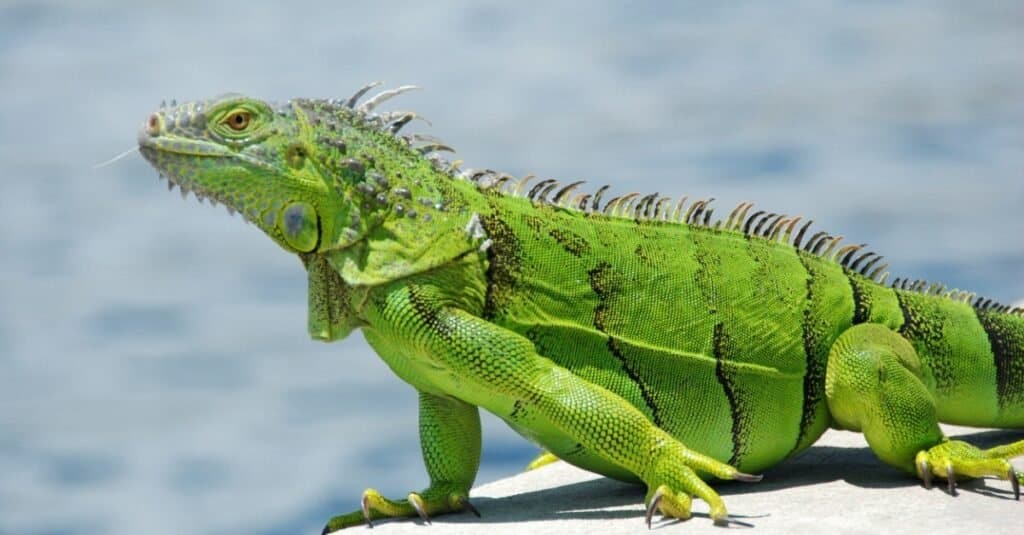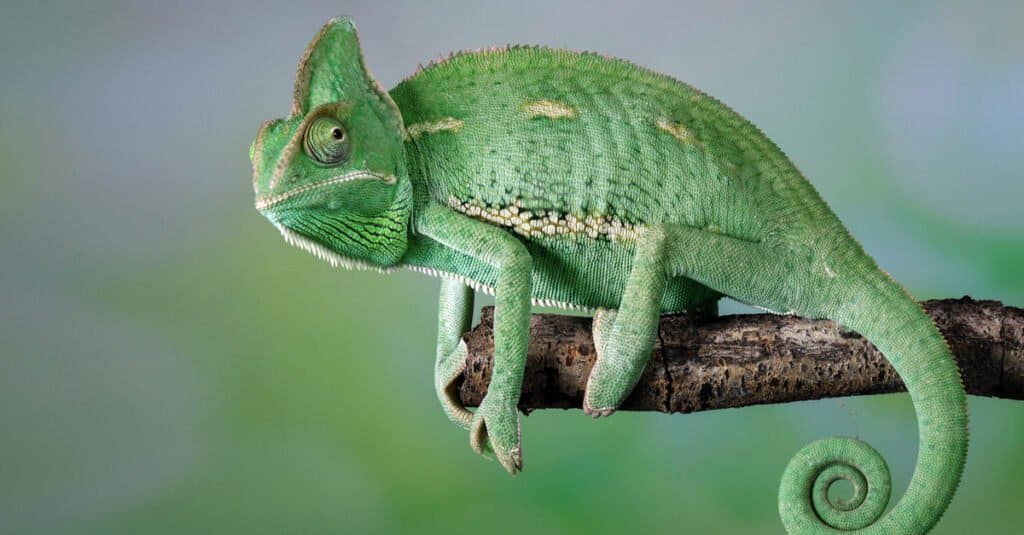Iguanas are large reptiles that live in the tropical areas of Central and South America. These lizards are hard to spot because they live high up in forest trees while having skin that allows them to blend in with their surroundings. Chameleons are another type of lizard that has a fantastic ability to blend in with the areas around them. Still, these reptiles are completely different from one another. Let us show you the differences between an iguana vs chameleon, and you’ll never confuse one for the other again!
Comparing an Iguana and a Chameleon
image needed: iguana vs chameleon
| Iguana | Chameleon | |
| Size | Weight: 8lbs-17.6lbs Length: 5ft-6ft including tails | Weight: 0.2lbs-4.4lbs Length: 1.5ft-2ft |
| Spines | Present on their backs | None |
| Location | Central and South America | Africa and parts of Asia |
| Defenses | Camouflage in their environment, but not as significantly as chameleons. | The ability to change colors and camouflage themselves |
| Lifespan | 15-20 years | 4-8 years |
| Tails | A long, powerful tail | A prehensile tail that can be used to grab things, including branches |
| Eyes | – Typical reptilian eyes – Possess a third, parietal eye that is a spot on their head rather than a fully developed eye. – Parietal eye helps to detect light. | – Scaly eyelid in a cone shape – Each eye can rotate and move in two directions at once, allowing them to focus on different objects |
The 7 Key Differences Between an Iguana vs Chameleon

Chameleons are much smaller than iguanas, but they can grow up to 2 feet long!
©Frank Glaw, Jörn Köhler, Oliver Hawlitschek, Fanomezana M. Ratsoavina, Andolalao Rakotoarison, Mark D. Scherz & Miguel Vences / Creative Commons – License
The biggest differences between an iguana and a chameleon lie in their size, location, defenses, and tails. Iguanas are much larger than chameleons, capable of reaching triple their length. Also, iguanas live in Central and South America while chameleons live in Africa and portions of South Asia, so these animals don’t share a range.
Chameleons can change their skin color to hide in their environments, but iguanas cannot. Lastly, iguanas have long tails that they can use to attack enemies, but a chameleon’s tail is prehensile and may be used to grab onto branches.
These major differences between iguanas and chameleons, but many others exist, and we’re going to explore them in greater detail.
Iguana vs Chameleon: Size

Iguanas can grow very large compared to chameleons
©Steve Cymro/Shutterstock.com
Iguanas are larger than chameleons. The average iguana will reach lengths of between 5ft and 6ft including their tails. However, chameleons will only reach lengths of 2ft at their longest.
Iguanas are heavier than chameleons, too. They can weigh between 8lbs and 17lbs, but chameleons weigh about a quarter of that at 4.4lbs. Thus, size is a very good way to tell an iguana from a chameleon.
Iguana vs Chameleon: Spines
Iguanas have spines on their back, but chameleons don’t. When you’re looking for ways to tell these lizards apart, spines are a good place to start. Don’t worry, though. Iguana spines only look sharp. They’re actually rather soft, but you don’t want to mess with them. They’re used as part of the iguana’s defensive efforts because they look sharp enough to scare away predators, and they help with internal processes like temperature regulation.
Iguana vs Chameleon: Location

Iguanas are native to Central and South America
©iStock.com/Travel_Bug
Iguanas are from Central and South America, but chameleons are from Africa and South Asia. These reptiles live far apart from each other and never share a range. Within those locations, you’ll find iguanas living high in trees where they will not be bothered by most other creatures.
Chameleons spend a lot of their time in trees, but they will also scurry across the ground, too. Overall, location can be a definitive way to tell the difference between what lizard you’re looking at.
Iguana vs Chameleon: Defenses
The defenses of an iguana are not as effective as a chameleon’s. Iguanas have various skin colors that help them blend in with their environment. However, they cannot change their skin color on a whim and that is the biggest difference between these creatures.
Adult male chameleons can change the color of their skin to blend in with their environment or help regulate their heat. However, younger chameleons and female chameleons are unable to change their color, but their skin colors are naturally duller and less likely to attract predators.
Iguana vs Chameleon: Lifespan
Iguanas live a lot longer than chameleons. Iguanas can live between 15 and 20 years in the wild and even longer in captivity. However, chameleons only live between 4 and 8 years in the wild and more in captivity. Some iguanas have been known to live up to 50 years in captivity, making them very long-lived pets.
Iguana vs Chameleon: Tails

Chameleons can use their tails to hold onto branches
©iStock.com/iluhanos
Iguanas have long tails that they use to swat foes, but chameleons have prehensile tails. The chameleon spends a fair amount of time in trees throughout its life. They can use their tail to grab ahold of a branch while they’re climbing or to help them snatch up an unsuspecting creature.
Iguanas’ tails are surprisingly tough, though. They’re often used to sweep prey off their feet, but they serve a defensive purpose as well. Iguanas can detach their tail and leave them behind when they are caught by predators. That way, the predator might leave them alone having gained a tail to eat, or it could give them a few seconds to make a run for their lives.
Both creatures have very interesting tails, but they each work in different ways.
Iguana vs Chameleon: Eyes

Chameleons have protruding, conical eyes
©Lauren Suryanata/Shutterstock.com
Chameleons have eyes that allow them to focus on two different objects at once, but iguanas have typical eyes. If you’re looking at these creatures, you can easily tell them apart by their eyes. Iguanas have eyes that are housed within their skull and are recessed like many other lizards.
However, chameleons have eyes that are house in a conical eyelid that protrudes from their head. Also, chameleons can use their eyes to look in different directions and focus on two different objects. Thus, if you see a lizard with eyes like these, you will be able to tell what they are right away.
Iguanas and chameleons have many differences that set them apart and make it easy to identify each creature. By looking at their size, eyes, spines, and tails, you will instantly know whether you are facing an iguana or a chameleon. These creatures do not like being surprised, so the chameleon might change colors and the iguana will probably scurry away!
The photo featured at the top of this post is © Laura Jonker/Shutterstock.com
Thank you for reading! Have some feedback for us? Contact the AZ Animals editorial team.






